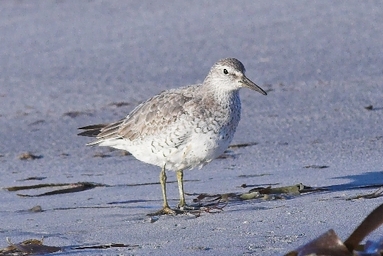What's that bird

Answering the question, "What's that bird?" can sometimes be a challenge. Birds are very active. The obstacles are many-the light may be dim, it may be blowing a gale, or the bird may "disappear" into a bush. So to stand the best chance of putting a name to a bird here are some handy hints.
Watch
When you see a bird, don't immediately try to flip through the pages of a field guide to identify it. Every moment of viewing time is precious. Keep your eye fixed on the bird and watch it-absorb details of its markings, movements, song, feeding habits, and size.
Listen
Listen to calls. If you don't make a conscious effort to listen, you won't remember the bird's song and you'll miss out on one of the best bird identification tools there is.
Estimate size
A general picture of the bird, that is its approximate size and shape, will often give you many clues when placing it into the correct family of birds. Therefore, begin with an assessment of the bird's overall appearance. What is the approximate size of the bird? It's easiest to estimate size in relation to well know birds. For instance, is the bird you're observing about the size of a sparrow or a blackbird or a crow?
Note details
Start at the head first. Look for distinctive strips and patches of colour including crown stripes, eye lines. Also note the colour and shape of the bird's bill.
Next, look for details on the bird's body, wings, and tail. Keep an eye out for wing bars, colour patches, and markings on the bird's body, when it is stationary or in flight. What colour is its back and its belly? How long is its tail in relation to the bird's body length? How does it hold its tail? Does it have a forked tail or is it square or rounded?
Now study the bird's legs. Does the bird have long legs or short legs? What colour are its legs?
Study behaviour
Does it walk or hop? If it is feeding, does it forage, tilting its head to watch for insects in the grass, or on the shore does it use its beak to probe the sand? If it flies off, watch for a pattern in its flight, does it swoop up and down in gentle arcs with each wing beat or does it glide gently and steadily?
Record your observations
After watching the bird, jot down your observations for later reference. Note the location, date, time of day of the sighting. From size to markings to behaviour, write down anything you noticed, it can all help when you later sit down with a field guide to answer that question "What's that bird?"
Useful Websites
Designed to improve your bird identification skills
Bird Identification. Nord-Trøndelag University College has created this website under the direction of Magne Husby. The work started in 2007 and the website was opened to the public in 2011. It will continue as a work in progress. It is an excellent site with lots of quizzes based on images and on sound. HiNT - BirdID http://www.birdid.no/index.php
The RSPB: Bird identifier http://www.rspb.org.uk/wildlife/birdidentifier/